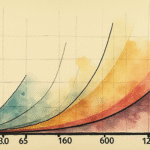Introduction
In the heart of Guerrero, Don Jesús anxiously observes his small grocery store. While insecurity was once a daily headache, it now seems like a secondary concern compared to the constant decline in sales this year. Don Jesús’ situation is not an exception but a tangible reflection of Mexico’s fragile economic moment.
Economic Projections and Concerns
International organizations like the IMF and World Bank project Mexico’s growth to be just above 1% in 2025, while domestic bank analysts foresee even gloomier scenarios, close to absolute stagnation. Banxico cautiously projects only 0.6%, even warning of negative figures.
This consensus among economists clearly reflects their worry about a weak and vulnerable economic environment. Commercial banks like BBVA and Banorte have also expressed caution, emphasizing that current risks are downwardly biased due to uncertainty surrounding public policies of the new government and external trade tensions.
Behind these cold numbers lies a concrete reality: private investment has started to slow down, hit by both internal and external uncertainties. High-interest rates, coupled with fear of uncertain policies post the 2024 presidential election, have led businesspeople to adopt a cautious stance and postpone key growth projects.
Internal and External Factors Affecting Investment
The uncertainty has roots both internally and externally. High-interest rates, along with fear of uncertain policies post the 2024 presidential election, have caused businesspeople to adopt a cautious stance and postpone key growth projects. Even Mexico’s strategic advantage in nearshoring seems insufficient to reverse this trend in the short term.
The political situation does not help either. Although the transition to Claudia Sheinbaum’s new government occurred without major incidents, continuity in certain economic policies, especially those linked to the energy sector and recent institutional reforms, keeps both domestic and international investors on edge. The perception of a fragile rule of law and fear of abrupt changes in economic rules have contributed to a loss of business confidence.
International Context Adding Complications
The international context adds more complications: tensions between the U.S. and Mexico have resurfaced strongly. The constant threat of U.S. tariffs and the pending review of the T-MEC increase uncertainty and further weaken investor confidence. Moreover, the projected economic slowdown in the U.S. for 2025 adds additional pressure on Mexican exports, traditionally the main driver of national growth.
The Likely Recession and Its Impact
In this context, the immediate outlook points to a probable recession. It won’t be dramatic, nor will it imply a crisis like those experienced before, but it will be a noticeable cooling that will hit, as always, the most vulnerable. Merchants like Don Jesús are already feeling this: fewer sales mean less income, fewer jobs, and a downward spiral that quickly propagates throughout the local economy.
The challenge for Mexico is enormous but not insurmountable. It requires quickly generating economic and political certainty to attract delayed investments. The time has come to abandon ambiguous economic policies, push a clear agenda, and provide unequivocal guarantees about respect for contracts and institutions. Otherwise, Don Jesús’ story won’t just be an isolated testimony but a faithful mirror of an economy that failed to capitalize on its opportunities.
Key Questions and Answers
- What are the economic projections for Mexico in 2025? International organizations like the IMF and World Bank project Mexico’s growth to be just above 1% in 2025, while domestic bank analysts foresee even gloomier scenarios, close to absolute stagnation.
- What factors are affecting private investment in Mexico? High-interest rates, coupled with fear of uncertain policies post the 2024 presidential election, have caused businesspeople to adopt a cautious stance and postpone key growth projects.
- How are international factors impacting Mexico’s economy? Tensions between the U.S. and Mexico, constant threat of U.S. tariffs, pending review of the T-MEC, and projected economic slowdown in the U.S. for 2025 add pressure on Mexican exports and weaken investor confidence.
- What is the likely scenario for Mexico’s economy in the near future? The immediate outlook points to a probable recession, characterized by noticeable cooling rather than dramatic crisis. This will disproportionately affect the most vulnerable, like Don Jesús, leading to fewer sales, less income, and job losses.






